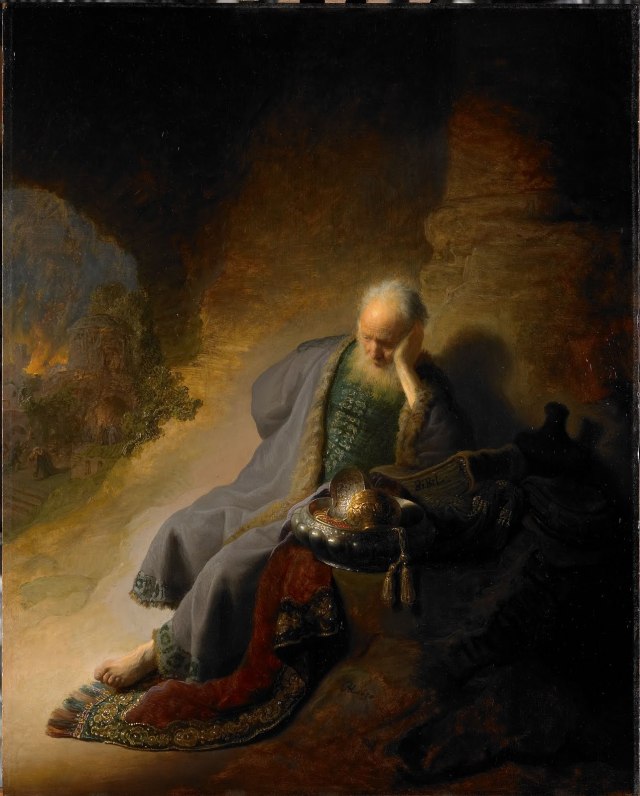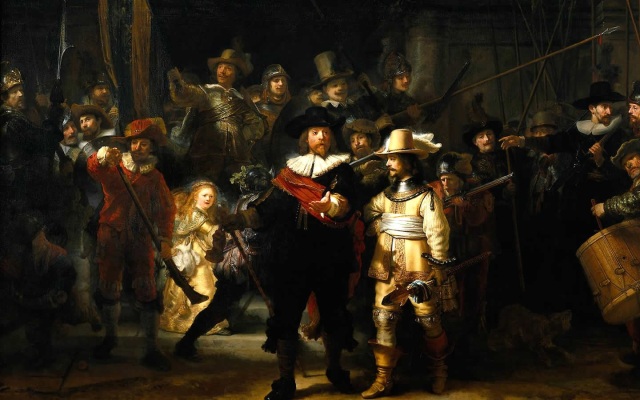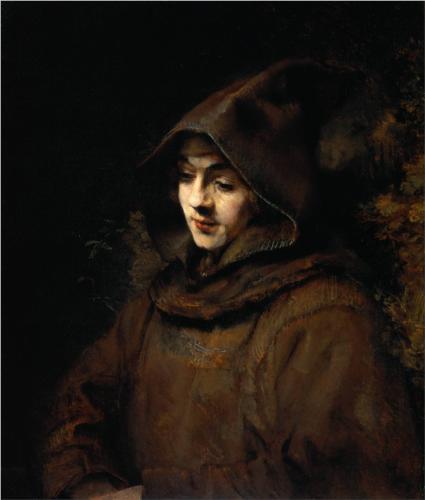I first posted about Rembrandt back in July, but I had so much material, I decided to do two separate posts. In the first one, I covered a basic life story and featured paintings that described the man himself, namely a self-portrait (he completed more than 90), and paintings of his wife Saskia, son Titus and common-law wife Hendrickje. These three are probably my favorite paintings by the artist. I will describe them chronologically by date produced.
Jeremiah Lamenting the Destruction of Jerusalem, 1630
I first discovered this painting in the gift shop of the Rijksmuseum, when I had gone back at age twenty-one to further explore the museum. My first trip was very rushed as we were part of a tour group, but for the second trip I was on my own and could take my time. I am a little embarrassed to say I don’t think I actually knew it was by Rembrandt, but just liked the look of it, especially the chiaroscuro aspects of it (the way the artist paints the light and darkness to explain the subject matter). According to the Bible, Jeremiah prophesied about the destruction of Jerusalem by the Babylonian King Nebuchadnezzar, which resulted in the beginning of the Babylonian Exile of the Jewish people. It is crazy to think that this painting was done when the painter was only 24 years old, as it shows a level of maturity not only in the subject matter but the way he handles it.
In the painting, as the title suggests, Jeremiah is upset over the destruction of Jerusalem, something he foretold but no one listened to him (rather like Cassandra during the Trojan War). The city of Jerusalem burns in the background of the painting. He leans on a Bible or what might be the Book of Jeremiah or the Book of Lamentations, and it is supporting him. He has managed to secure a few of the holy relics that were kept in the Temple of Solomon, seen burning in the background. To get a glimpse into the mind of the prophet, I found this website which seems to best describes it: “Jeremiah had failed as a prophet of the Lord to convince his people of the city’s destruction and was punished for it by the king. Though the fault was not his, the guilt must have weighted heavily on his mind. The guilt and the pain of a failed prophet was revealed in this painting.”
The Company of Captain Frans Banning Cocq and Lieutenant Willem van Ruytenhurch , 1642
As I have said in the previous post, I first saw this painting when I was sixteen on my first remembered trip to Europe. I was in awe of its size at first glance (nearly 12 x 14 ft), though it was many years and Baroque art history class before I could actually tell you anything of consequence about the painting. The title it is known most often by isThe Night Watch, which is ironic, as the original painting was not set during night-time but the day. A dark varnish had been applied for most of its life, due to the brown that Rembrandt was found of using, and that combined with several hundred years of dirt had made it appear dark.
The painting shows a group portrait of a city militia led by Captain Frans Banning Cocq, who was also the mayor of Amsterdam. According to this Guardian post,
“Companies of urban militia were part of the everyday life of the Dutch Republic, as it asserted its independence from the Spanish empire. Instead of a distinguished company of worthy officers and well-trained men Rembrandt shows a baroque profusion of gestures and expressions, a raggle taggle crowd of comic types from an old soldier hunched over his gun to the preening figures of the militia captain and his lieutenant Willem van Ruytenburch. Rembrandt’s masterpiece in modern times has come to epitomize Dutch national pride.”
The piece was commissioned by the Captain and 17 members of his guard. There were more members of the company of men, but only 18 paid, so they were featured in the painting. Rembrandt added an additional 16 figures to make the scene more animated. According to this page, ironically by the time the painting was completed, watches were no longer needed. “Their meetings had been diverted chiefly to social or sporting purposes; if they may be said to have any particular destination in the painting, it is perhaps to march into the fields for a shooting contest or to take part in a parade.” The painting was originally placed in the Kloveniersdoelen, or the headquarters of the Arquebusiers (Musket-bearing civic guard) in Amsterdam. It was later moved in 1715 to Amsterdam’s Town Hall and it was then that the painting was damaged and two figures on the left side were cut off to make sure the painting would fit. It eventually ended up in the newly finished Rijksmuseum in 1885 and has remained there ever since.
The painting is unique as it was “by far the most revolutionary painting Rembrandt had yet made, transforming the traditional Dutch group portrait into a dazzling blaze of light, color and motion, and subordinating the requirements of orthodox portraiture to a far larger, more complex but still unified whole.” The men in the painting are shown in action, in the middle of getting ready for a patrol. You can almost hear the men shouting, the drums being played, the dog barking and muskets being loaded as everyone prepares. The Captain is featured in the center of the painting in dark clothing and a red sash, with hand outstretched. His lieutenant is dressed in yellow with a white sash. Yellow was seen as the color of victory, which is completely different than its connotations nowadyas. Rembrandt reportedly placed himself in the painting in the center, to the left behind the Captain. The man immediately to Rembrandt’s left is holding up the company’s colors with the flags. There is a dog to the right of the lieutenant, though he may be hard to see, as part of the dog is on the spot where the painting was attacked in 1975 and there was a zigzag rip in the piece. The little girl bathed in golden light to the left of the captain is a bit of a mystery. Some believe that she is the mascot of the company, as she is shown with, according to this Wikipedia article “the claws of a dead chicken on her belt represent the clauweniers (arquebusiers); the pistol behind the chicken stands for ‘clover’; and, she is holding the militia’s goblet.” Some believe that Rembrandt’s wife Saskia was used as a model for the girl, and I must say that there is a resemblance. I can’t say for sure if this is true as she died the same year the painting was completed.
To learn more about this piece, check out this CNN article. To check one way that The Night Watch has influenced popular culture is to check out this flashmob created by the Rijksmuseum called “Our Heroes Are Back” done at a Dutch shopping mall in April 2013. I thought this was a great idea, especially as it was highlighting the reopening of the museum (after its’ 10 year remodeling closure from 2003-2013). I wish people would do things like this in American shopping centers to celebrate art.
The Jewish Bride, c. 1665-1669
This painting is known as one of the greatest portraits ever created, and is one of the best the Rembrandt painted in the final years of his life. It is not actually known who the painting is supposed to depict, but most art historians believe the painting to be a couple portrait with the figures representing Isaac and Rebecca from the Old Testament. According to this website (which quotes the Rijksmuseum – where the painting resides):
“The painting became known as the ‘Jewish Bride’ in the early 19th century after the Amsterdam art collector, Van der Hoop, identified the subject of the painting as a Jewish father hanging a necklace around his daughter’s neck on her wedding day. In light of this interpretation, several scholars claim the couple could be figures from the bible, perhaps Isaac and Rebecca (having masked the true nature of their relationship to the Philistine king Abimelech), Jacob and Rachel, Judah and Tamar or Boaz and Ruth, or a variety of figures from the New Testament and the Apocrypha.” For more information on whether or not The Jewish Bride is actually Jewish or not, check out the above link.
On to the content of the painting itself. I will admit that the first time I saw this painting, I thought it was a little pervy. Is he coping a feel, putting a necklace on or pledging his love to her by placing his hand over her heart? Having studied art history in past and more to the point, Baroque art, especially Rembrandt’s work, I would go for the final answer. My interpretation is backed up by this website which says, “The man places his hand on the woman’s bosom, while she moves instinctively to protect her modesty, in keeping with the new aesthetics of Protestant Reformation Art (c.1520-1700). Yet both show every sign of tenderness towards each other, so this is hardly a typical seduction scene.”
Whoever the subjects of the painting were in real life, they are obviously very well off, as exemplified by the rich reds and golds used. According to this website: “Rembrandt used a palette knife instead of a brush to apply the gold on the man’s sleeve with thick strokes which reflect the light, and in the woman’s red dress some parts are laid on so thickly that the paint itself creates light and shadow. The man’s coat consists of several layers of paint not only applied but also scratched and scraped to give the effect of cloth of gold.”








You must be logged in to post a comment.